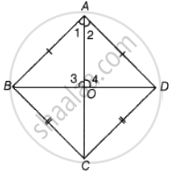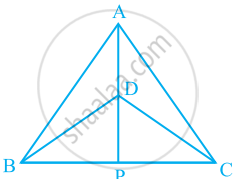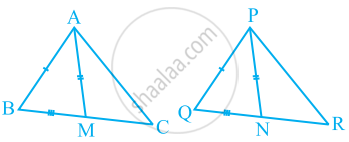Advertisements
Advertisements
Question
ABC and DBC are two triangles on the same base BC such that A and D lie on the opposite sides of BC, AB = AC and DB = DC. Show that AD is the perpendicular bisector of BC.
Solution
Given in the question, ABC and DBC are two triangles on the same base BC such that A and D lie on the opposite sides of BC, AB = AC and DB = DC.

To proof that AD is the perpendicular bisector of BC that is OB = OC.
Proof: In triangle BAD and triangle CAD,
AB = AC ...[Given]
BD = CD ...[Given]
AD = AD ...[Common side]
Now, by SSS criterion of congruence,
ΔBAD ≅ ΔCAD
So, ∠1 = ∠2 ...[CPCT]
Now, in triangle BAO and triangle CAO,
AB = AC ...[Given]
∠1 = ∠2 ...[Proved above]
AO = AO ...[Common side]
So, by SAS criterion of congruence,
ΔBAO ≅ ΔCAO
Since, BO = CO ...[CPCT]
And ∠3 = ∠4 ...[CPCT]
∠3 + ∠4 = 180° ...[Linear pair axiom]
∠3 + ∠3 = 180°
2∠3 = 180°
∠3 = `(180^circ)/2`
∠3 = 90°
Therefore, AD is perpendicular to bisector of BC.
Hence proved.
APPEARS IN
RELATED QUESTIONS
ABC is a right angled triangle in which ∠A = 90° and AB = AC. Find ∠B and ∠C.
ΔABC and ΔDBC are two isosceles triangles on the same base BC and vertices A and D are on the same side of BC (see the given figure). If AD is extended to intersect BC at P, show that
- ΔABD ≅ ΔACD
- ΔABP ≅ ΔACP
- AP bisects ∠A as well as ∠D.
- AP is the perpendicular bisector of BC.

AD is an altitude of an isosceles triangles ABC in which AB = AC. Show that
- AD bisects BC
- AD bisects ∠A
Two sides AB and BC and median AM of one triangle ABC are respectively equal to sides PQ and QR and median PN of ΔPQR (see the given figure). Show that:
- ΔABM ≅ ΔPQN
- ΔABC ≅ ΔPQR

BE and CF are two equal altitudes of a triangle ABC. Using RHS congruence rule, prove that the triangle ABC is isosceles.
ABC is an isosceles triangle with AB = AC. Drawn AP ⊥ BC to show that ∠B = ∠C.
In two right triangles one side an acute angle of one are equal to the corresponding side and angle of the other. Prove that the triangles are congruent.
Prove that in a quadrilateral the sum of all the sides is greater than the sum of its diagonals.
Prove that sum of any two sides of a triangle is greater than twice the median with respect to the third side.
ABCD is a quadrilateral such that diagonal AC bisects the angles A and C. Prove that AB = AD and CB = CD.
